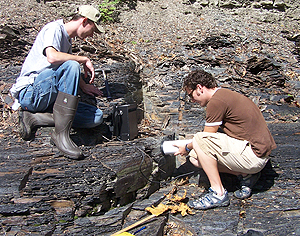|
|
|
Dr. Lash and Mr. Blood will be delivering several papers and leading a field trip to the shale exposed along the shoreline near Hamburg, NY, during the upcoming eastern regional meeting of the American Association of Petroleum Geologists in Buffalo. |
New interest in drilling natural gas from black shale is pumping energy into the geosciences department at SUNY Fredonia.
Two recent gifts of industry-level software valued at $54,000 have come into the lab of Dr. Gary Lash in Houghton Hall (read more about his field research program). Papers describing his work on fractured Devonian black shale deposits are being presented to packed rooms at major meetings, and his students and graduates are reaping the benefits.
“We’re looking at the Marcellus Shale, which is one of the black shale units attracting industry attention,” Dr. Lash said. “It’s buried pretty deep and is very organic rich. You can smell the gas in the shales. You break that black shale on the beach and you can smell the gas coming out of it. So it’s in there. The problem is getting it out. The Marcellus is extremely tight.”
Using basic, old-fashioned field geology that takes them out of Houghton Hall and on forays along local creeks and the Lake Erie shoreline, Dr. Lash and his students are collecting the type of data that can be applied to the exploration of these rocks at great depth. “We’re trying to link what we see on the surface to the subsurface,” he said.
Powerful software boosts research program
Analyzing data from a myriad of sources to predict where and when the natural gas in the black shale formed, Dr. Lash’s tools are among the best available—from a gamma ray spectrometer, to a database of facts and figures on more than 1,000 gas wells already drilled in the Appalachian basin, and ultimately, to a pricey piece of modeling software called Petroleum Systems Suite that even major universities usually can only dream about.
A gift from Platte River Associates of Boulder, CO, the product was designed for the oil and gas industry but is donated to academic geologists on a competitive basis. “It really is amazing software and is a feather in our cap to have it,” Dr. Lash said. Typical of the teaching faculty at Fredonia, Dr. Lash may even be more excited by the fact that the gift comes with a summer internship offer in 2007 for a SUNY Fredonia student.
Fredonia students reap the benefits
Geosciences graduate Randy Blood has already made a name for himself by collaborating with Dr. Lash, first as an undergraduate and now while he’s completing his master’s degree at SUNY at Buffalo. He is a co-author on 10 abstracts of papers presented at regional and national meetings, as well as four papers (one in press) published in scientific journals. When he finishes his master’s degree this December, Mr. Blood has a job waiting for him with Chesapeake Energy, one of the U.S.’s largest independent producers of natural gas and an active driller of new wells in the Appalachian Basin.
From one gas boom to another
The department’s expert in sedimentary geology, Dr. Lash came to Fredonia in the early 1980s when the previous gas boom drained Fredonia of some top faculty who left academe for industry. At that time, Dr. Lash’s research focused on rocks at the tectonic scale and he’s been consistently publishing in that field for over two decades. But seven years ago, he shifted to the micrometer scale—where hydrocarbons, gamma rays, and temperatures hold the secrets of finding natural gas.
He didn’t realize it, but his timing was perfect—by getting into the thick of the work a few years ahead of the new energy crisis, he was up to speed—already publishing and presenting papers--when industry began looking for help.
“The petroleum engineers determine the engineering aspects of the drilling, but they need to know something about the rock they are drilling into,” Dr. Lash said.
Black Shale doesn't give up the goods easily
Packed with hydrocarbons, black shale has been the bane of petroleum engineers: it is too deep and tightly compressed to give up gas easily, and until the price of natural gas recently soared, it wasn’t worth the money to go after it. Even when a well was drilled, the productivity was iffy—black shale is so tightly bonded that gas doesn’t have a pathway to migrate out. Then, in the 1990s, an energy company in Texas began recovering natural gas from the Barnett black shale above Fort Worth, now one of the most prolific gas-producers in the country. The drillers spent 20 years struggling with the technology necessary to compel the Barnett to give up the goods and its ultimate success has raised interest in black shale across the country.
Taking the lessons learned in Texas and applying them to the local black shale, Dr. Lash is working with a Meadville, PA., company to find ways of inducing fractures in the rock and getting the gas to move. "There's always been a problem getting the gas out of these shales," Dr. Lash said. "But we're getting a pretty good understanding of them and gaining attention as a result of our work."




